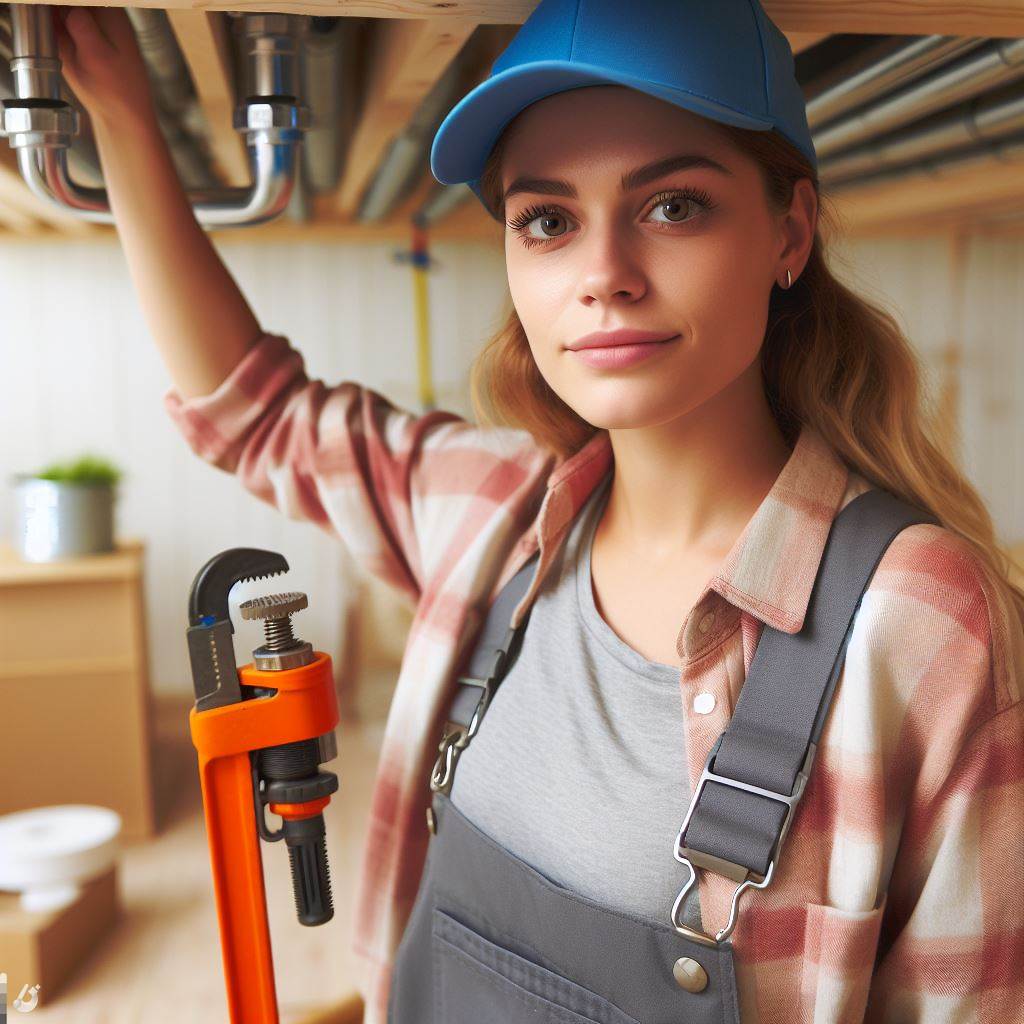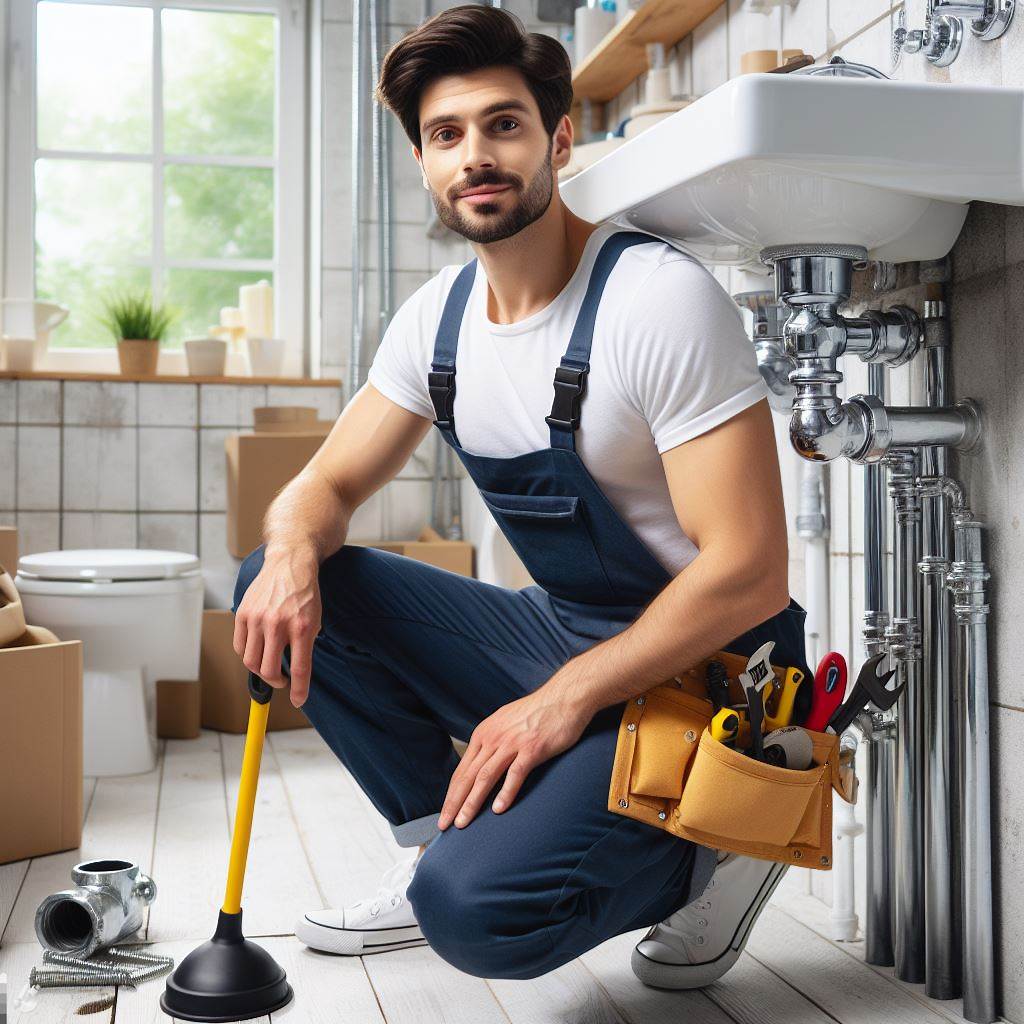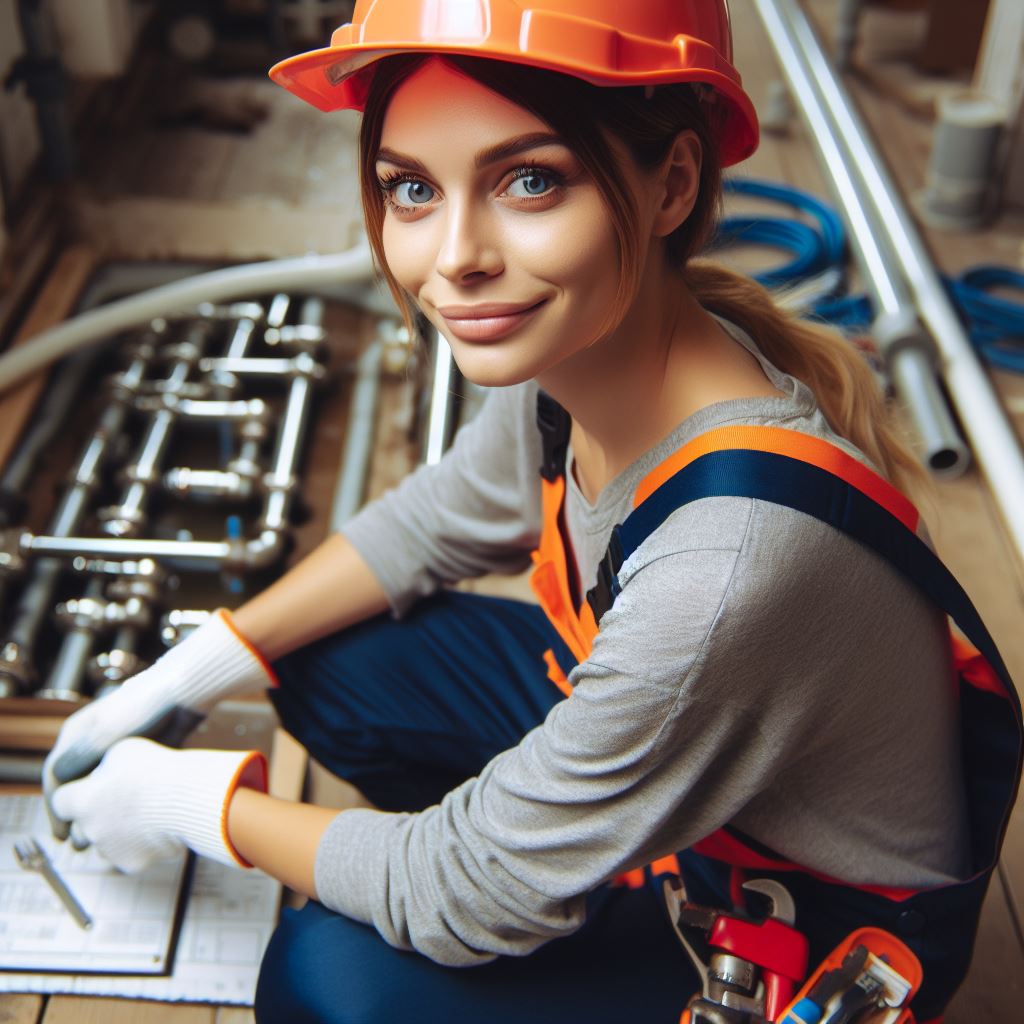Introduction
Women have been breaking stereotypes and entering industries that were once dominated by men.
This includes the field of plumbing, where the trends are changing with increasing female representation.
Traditionally, plumbing has been seen as a male-dominated profession, with few women pursuing careers in this industry.
The perception that plumbing is physically demanding and dirty work has discouraged many women from considering it as a career option. However, times are changing.
The plumbing industry in Canada is witnessing a remarkable shift as more women break barriers and enter this traditionally male-dominated field.
Over the years, the number of women choosing plumbing as a profession has been steadily increasing.
They are challenging the notion that plumbing is exclusively for men, proving that gender does not limit one’s ability to excel in this field.
One reason for this positive shift is the growing support and encouragement from organizations and associations within the plumbing industry.
They recognize the importance of diversity and are actively promoting gender inclusivity.
The changing trends in the plumbing industry can also be attributed to a change in societal attitudes.
Increasingly, people are recognizing the value of diversity and equality in the workplace.
This allows women to have equal opportunities and access to plumbing training and employment.
Moreover, the demand for skilled plumbers in Canada has been steadily rising, creating a need for more professionals in the field.
Women, who were once discouraged from pursuing plumbing, are now stepping forward, recognizing the potential for growth, job security, and financial stability.
In short, the plumbing industry in Canada is witnessing a significant shift with increasing female representation.
Through changing societal attitudes and the support of organizations, more women are pursuing careers in plumbing.
As the industry continues to evolve, it is essential to recognize and appreciate the contributions of women in this traditionally male-dominated field.
Overview of the Plumbing Industry in Canada
Importance of the Plumbing Industry in Canada
The plumbing industry in Canada plays a crucial role in maintaining public health and safety standards.
Plumbing systems are responsible for ensuring the supply of clean and safe water, which is essential for drinking, cooking, and sanitation purposes.
Without a well-functioning plumbing infrastructure, the risk of waterborne diseases and contamination would significantly increase.
Plumbers are responsible for designing, installing, and repairing the intricate network of pipes, fittings, and fixtures that make up plumbing systems.
In addition to providing clean water supply, plumbing systems also facilitate the proper disposal of wastewater and sewage.
Adequate wastewater management is necessary to prevent environmental pollution and maintain the overall hygiene of communities.
Considering the various sectors that rely on plumbing, such as residential, commercial, and industrial, the importance of the plumbing industry becomes evident.
From households to businesses, everyone needs functional plumbing systems for their daily operations and well-being.
Unlock Your Career Potential
Visualize a clear path to success with our tailored Career Consulting service. Personalized insights in just 1-3 days.
Get StartedCurrent Demand for Plumbers and the Job Market in the Industry
The demand for skilled plumbers in Canada is on the rise.
The country’s rapid urbanization, infrastructure development, and increasing population contribute to this growing demand.
As cities expand, there is a need for new buildings, homes, and infrastructure systems, all requiring plumbing expertise.
Additionally, the aging infrastructure across the country necessitates plumbing repairs and maintenance.
Older buildings and outdated plumbing systems require regular upgrades, creating job opportunities for plumbers.
The job market in the plumbing industry is relatively stable and provides good prospects for employment.
Skilled and certified plumbers are in high demand, which translates to job security and potential career growth.
Furthermore, experienced plumbers can potentially start their own businesses and work independently.
Traditionally Male-Dominated Nature of the Field
The plumbing industry has been traditionally dominated by men. Stereotypes and societal expectations have discouraged women from pursuing careers in the field.
Plumbing, often perceived as physically demanding and dirty work, has been considered more suitable for men based on these stereotypes.
Consequently, women remain underrepresented in the plumbing industry.
However, in recent years, there has been a significant push for gender equality and inclusion in typically male-dominated fields.
Efforts are being made to encourage and support women in exploring opportunities in plumbing.
Various organizations and initiatives aim to break down barriers and provide training and support specifically for women interested in pursuing a career in plumbing.
These efforts strive to challenge gender stereotypes and create a more diverse and inclusive industry.
In review, the plumbing industry in Canada is of utmost importance for ensuring clean water supply, proper sanitation, and public health.
The demand for skilled plumbers is increasing, presenting favorable job prospects.
While traditionally male-dominated, there is a growing push for gender equality and inclusivity in the field, aiming to address the underrepresentation of women and encourage their participation in plumbing.
Read: Plumbing Unions in Canada: Benefits & Joining
Historical Context: Women in Plumbing
Brief Introduction and Historical Exclusion
Throughout history, women have faced numerous challenges and barriers when it comes to pursuing careers in plumbing.
Traditionally, plumbing was considered a male-dominated profession, and women were largely excluded from this field.
For centuries, society has perpetuated the idea that plumbing is physically demanding and inappropriate for women.
As a result, women were discouraged from entering the plumbing industry due to societal barriers and gender stereotypes.
Societal Barriers and Stereotypes
- Limited Opportunities: Women faced limited opportunities to learn plumbing skills due to the lack of training programs available to them. This restricted their chances of finding employment in the field.
- Discrimination: Women were often discriminated against in terms of job hiring and promotions. Many employers believed that women were incapable of carrying out plumbing tasks effectively.
- Lack of Support: Society often failed to provide adequate support and encouragement to women who desired to become plumbers. This lack of support amplified the existing barriers.
- Double Standards: Women in plumbing were subjected to higher scrutiny and unfair judgments. They had to prove themselves constantly, facing skepticism from both colleagues and clients.
Notable Exceptions and Trailblazers
Despite these challenges, some brave women broke the barriers and made significant contributions to the plumbing industry:
- Mary Fergusson: In the late 1800s, Fergusson became one of the first women to pursue a plumbing apprenticeship, defying societal norms and expectations.
- Lillian Baumbach: Baumbach, in the early 1900s, became the first female licensed plumber in Canada, inspiring other women to follow in her footsteps.
- Judith Smith: Smith, in the 1970s, founded the Women in Plumbing and Heating Association, advocating for equal opportunities and challenging gender bias.
- Stephanie Jojokian: Jojokian, in the 2000s, established her own successful plumbing company, empowering women and demonstrating their skill and competence in the field.
These exceptional women not only shattered stereotypes but also paved the way for future generations of women to enter the plumbing industry.
The historical exclusion of women in plumbing stemmed from societal barriers and pervasive stereotypes.
However, notable exceptions and trailblazers like Mary Fergusson, Lillian Baumbach, Judith Smith, and Stephanie Jojokian have played vital roles in challenging these norms and breaking down barriers.
It is essential to acknowledge the progress made in recent years towards gender equality in the plumbing industry.
However, there is still much work to be done to encourage and support more women to pursue plumbing as a viable and rewarding career path.
Breaking free from historical constraints, we must embrace diversity and equality, ensuring equal opportunities for all aspiring plumbers, regardless of gender.
Read: Green Plumbing: Canada’s Eco-Friendly Practices
Changing Trends in Female Representation
The shift in societal mindset towards gender equality and inclusivity
Over the years, there has been a significant shift in societal mindset towards gender equality and inclusivity.
Women are breaking barriers and making their mark in traditionally male-dominated professions like plumbing.
Recognition of Women’s Value and Skills
Previously, there was a misconception that plumbing required physical strength and was better suited for men.
However, society is now recognizing the unique value and skills that women bring to the plumbing profession.
Women are inherently detail-oriented and possess excellent problem-solving skills, making them well-suited for plumbing tasks that require precision and critical thinking.
They also have exceptional communication and customer service abilities, which are vital for establishing trust and building strong relationships with clients.
Growing Number of Women in the Plumbing Industry
The plumbing industry is witnessing a significant increase in the number of women entering the field.
According to recent statistics, the percentage of women working as plumbers in Canada has been steadily rising over the past decade.
In 2010, only 3% of plumbers in Canada were women. However, by 2020, this number had grown to 10%, showcasing a steady upward trend.
This growth can be attributed to various factors, such as increased awareness about gender equality, improved access to education and training, and the changing perception of plumbing as a viable career option for women.
Benefits of Women in Plumbing
Having more women in the plumbing industry provides numerous benefits for both individuals and society as a whole.
Firstly, it helps break down gender stereotypes and promotes a more inclusive and diverse workforce.
This creates a positive work environment where everyone’s skills and expertise are valued, regardless of gender.
Secondly, women bring unique perspectives and approaches to problem-solving, fostering innovation and creativity within the industry.
Moreover, having female plumbers enhances customer satisfaction as they can provide a more empathetic and understanding approach towards clients’ needs.
Lastly, increasing the representation of women in plumbing provides excellent role models for young girls and inspires them to pursue careers in traditionally male-dominated fields.
Challenges and Solutions
While progress is being made, there are still challenges that women face in the plumbing industry.
One of the main obstacles is the physical demands of the job, which can be daunting for some women.
However, this can be overcome through proper training, access to ergonomic tools, and supportive work environments.
Another challenge is the lack of female mentors and role models in the field.
Initiatives promoting mentorship programs and networking opportunities can help address this issue and provide guidance to aspiring female plumbers.
Furthermore, raising awareness and dispelling gender stereotypes about plumbing through education and outreach programs is crucial for encouraging more women to consider this profession.
The Way Forward
The changing trends in female representation within the plumbing industry signify a positive transformation towards gender equality.
It is essential to continue supporting and encouraging women to pursue careers in plumbing through scholarships, training programs, and workplace initiatives.
To sustain and further increase the number of women in plumbing, collaboration between educational institutions, industry associations, and government bodies is vital.
By embracing gender equality and inclusivity, the plumbing industry can benefit from a diverse and talented workforce, ultimately leading to improved innovation, customer satisfaction, and societal progress as a whole.
In essence, the changing trends in female representation in the plumbing industry are proof of the evolving mindset towards gender equality and inclusivity.
Women are increasingly recognized for the value and skills they bring to the profession, with the numbers entering the field steadily rising.
With continued support and efforts, the industry can foster a diverse and inclusive environment for female plumbers, benefiting individuals, society, and the future generation.
Read: Latest Plumbing Trends in the Canadian Market
Factors Contributing to the Rise of Women in Plumbing
The role of educational institutions and vocational programs in encouraging women to pursue plumbing
Educational institutions and vocational programs play a significant role in encouraging women to pursue plumbing as a career.
These institutions provide training and education that are essential for women to gain the necessary knowledge and skills in plumbing.
Many educational institutions have recognized the need for gender diversity in traditionally male-dominated fields like plumbing.
They offer specialized programs and courses that specifically target women who are interested in pursuing a career in plumbing.
These programs aim to break down the barriers and challenges that women may face when entering the industry.
Vocational programs, on the other hand, provide practical hands-on training that is highly relevant in the plumbing field.
They not only equip women with the technical skills needed for the trade but also offer the opportunity to network and connect with industry professionals, further enhancing their chances of success.
The importance of mentorship programs and support networks for women in entering and thriving in the industry
Mentorship programs and support networks are crucial in assisting women in entering and thriving in the plumbing industry.
These programs provide guidance, advice, and support from experienced professionals who have navigated the challenges that women may encounter as they enter the field.
By having access to mentors who can share their firsthand experiences, women in plumbing can learn from their successes and failures, gain valuable insights, and build their confidence.
Mentorship also helps create a strong support system, which is essential for women to thrive amidst potential gender biases or discrimination.
The efforts of plumbing associations and organizations in promoting diversity and gender equality in the field
Furthermore, plumbing associations and organizations play a vital role in promoting diversity and gender equality in the plumbing industry.
These organizations actively encourage women to pursue careers in plumbing and offer resources and support to help them succeed.
They may collaborate with educational institutions and vocational programs to develop initiatives and scholarships aimed at increasing female representation within the industry.
They also provide networking opportunities and forums for women to connect, share experiences, and support one another.
Plumbing associations and organizations play a crucial role in raising awareness about the contributions and achievements of women in plumbing.
By showcasing successful women in the field, they challenge stereotypes and inspire other women to consider plumbing as a viable career option.
In general, the rise of women in plumbing can be attributed to various factors.
Educational institutions and vocational programs provide the necessary training and education, while mentorship programs and support networks create a supportive environment for women to excel in the industry.
Plumbing associations and organizations promote diversity and gender equality, further encouraging women to pursue plumbing as a career.
Together, these factors contribute to the increasing presence of women in the plumbing field, breaking down barriers and opening doors for more opportunities.
Read: Safety Tips for Plumbers: A Canadian Perspective

Success Stories: Profiles of Women Plumbers
Women in the plumbing industry have been making significant strides, challenging traditional norms, and debunking stereotypes.
Here, we highlight some inspiring success stories of women plumbers in Canada who have paved the way for change.
Inspiring stories of successful women plumbers in Canada
1. Jane Adams
Jane Adams, a trailblazer in the plumbing industry, started her career as an apprentice plumber in Toronto. Despite facing initial skepticism, she worked tirelessly to prove her worth.
Over the years, Adams excelled in her field, earning recognition for her exceptional skills and dedication. She successfully completed several complex projects and became a trusted plumber in her community.
Challenges were not uncommon for Adams, but she never let them deter her.
Instead, she used them as motivation to push herself further and break barriers for future generations of women plumbers.
Adams’ achievements have reshaped the narrative surrounding women in plumbing, demonstrating that gender should never limit one’s potential or opportunities in this field.
2. Samantha Carter
Samantha Carter, a highly accomplished plumber based in Vancouver, has revolutionized the industry with her innovative solutions and exceptional problem-solving skills.
Throughout her career, Carter has faced various challenges, including prejudice and skepticism from male colleagues and clients.
However, her determination and expertise have allowed her to overcome these barriers and gain respect in the industry.
Carter’s contributions have not only transformed the perception of women in plumbing but also elevated the overall standards of the profession.
Her commitment to providing quality service has set new benchmarks for excellence.
3. Maria Martinez
Maria Martinez, hailing from a small town in Alberta, has emerged as a role model for aspiring women plumbers across Canada.
Despite coming from a non-traditional background, Martinez’s passion for plumbing compelled her to pursue a career in the field.
She faced initial resistance but stayed resilient, working diligently to prove herself.
Today, Martinez is celebrated for her extraordinary skills and relentless determination.
Her success has opened doors for women from diverse backgrounds who aspire to make their mark in the plumbing industry.
4. Heather Thompson
Heather Thompson, a seasoned plumber from Montreal, has made immense contributions to the industry through her commitment to sustainability and eco-friendly practices.
Thompson’s interest in sustainable plumbing solutions led her to specialize in green plumbing techniques.
Her expertise and dedication have garnered recognition from both peers and clients.
By emphasizing the importance of environmentally conscious plumbing practices, Thompson has not only made a positive impact on the industry but also on the communities she serves.
The success stories of these remarkable women plumbers demonstrate their resilience, determination, and ability to challenge prevailing stereotypes.
Through their achievements, they have contributed to changing the narrative surrounding women in plumbing, inspiring future generations to break barriers and pursue their passion.
These women have showcased their positive impact on the industry, elevating its standards and reshaping societal perceptions.
As the plumbing industry continues to evolve, it is essential to celebrate the achievements of women and encourage further progression towards gender equality in this traditionally male-dominated field.
Benefits of Women in the Plumbing Industry
The advantages of having more women in the plumbing workforce
Having more women in the plumbing workforce brings numerous advantages to the industry.
In this blog section, we will explore the benefits that women contribute and how their presence positively impacts the profession.
The diverse perspectives, problem-solving skills, and communication abilities that women bring to the field
Problem-solving skills
Firstly, women bring unique problem-solving skills to the field of plumbing.
Their diverse perspectives and experiences allow them to approach challenges from different angles, leading to innovative solutions.
This diversity strengthens the problem-solving capacity of the entire industry, fostering creativity and efficient problem resolution.
communication abilities
In addition to their problem-solving abilities, women also possess excellent communication skills.
Effective communication is crucial in the plumbing industry, where clear instructions and explanations are essential for successful projects.
Women’s natural talents in communication help facilitate smooth interactions with clients, colleagues, and other stakeholders, ensuring that information is understood and actions are executed accurately.
The increased comfort and trust that female clients may have when working with women plumbers
Another significant advantage of having women in the plumbing workforce is the increased comfort and trust that female clients may have when working with women plumbers.
In many cases, plumbing issues require entry into personal spaces such as bathrooms and bedrooms.
Female clients often feel more at ease when a female plumber is present, avoiding potential discomfort or uneasiness.
This increased comfort enhances customer satisfaction and loyalty.
Moreover, the inclusion of women in plumbing fosters a more diverse and inclusive work environment.
By breaking gender stereotypes, it encourages other women to pursue careers in the industry.
This increased diversity not only benefits women but also promotes creativity, innovation, and productivity within teams.
Companies with diverse workforces tend to have higher employee morale, higher retention rates, and a more positive reputation.
It is important to note that the benefits of having more women in plumbing extend beyond the individual level.
As more women enter the field, the overall perception of the profession evolves.
Plumbing becomes more gender-neutral, breaking down the barriers that previously discouraged women from pursuing plumbing as a career.
This cultural shift ensures equal opportunities for both genders and promotes gender equality in the workforce.
In a nutshell, the advantages of having women in the plumbing industry are undeniable.
Their diverse perspectives, problem-solving skills, and communication abilities enrich the entire profession.
Moreover, female clients benefit from the increased comfort and trust they experience when working with women plumbers.
The inclusion of women also creates a more diverse and inclusive work environment and breaks down gender stereotypes.
As the industry continues to evolve, it is essential to embrace the contributions and recognize the value that women bring to the field of plumbing.
Overcoming Challenges and Addressing Barriers
Women in the plumbing industry in Canada face several challenges and barriers when it comes to entering and advancing in the field.
However, there are potential strategies that can be implemented to overcome these challenges and create a more inclusive industry.
Remaining Challenges and Barriers
- Lack of representation and visibility: Women often face a lack of representation and visibility in the plumbing industry, which can discourage them from pursuing a career in this field.
- Stereotypes and societal expectations: Stereotypes and societal expectations still persist, with many people believing that plumbing is a male-dominated profession.
- Unequal access to opportunities: Women may face unequal access to apprenticeship programs, training, and job opportunities in the plumbing industry.
- Hostile work environments: Some women experience discrimination, harassment, and a lack of support in their workplaces, making it challenging to progress in their careers.
- Limited networking opportunities: Networking plays a crucial role in career advancement, but women may face difficulties in building professional networks due to their underrepresentation.
Potential Strategies to Overcome Challenges
Addressing these challenges requires a multi-faceted approach that involves various stakeholders, including educational institutions, policymakers, industry organizations, and employers.
- Educational initiatives: Encouraging women to pursue plumbing as a career choice through targeted educational initiatives and outreach programs can help break down stereotypes and increase their representation.
- Policy changes: Implementing policies that promote gender equality and diversity in the plumbing industry can create a more inclusive environment for women.
- Breaking stereotypes: Raising awareness about the successful women in the plumbing industry and challenging gender stereotypes can help change societal perceptions and create more opportunities for women.
- Mentorship and support programs: Providing mentorship and support programs specifically tailored for women in plumbing can help them navigate the industry and address the unique challenges they may face.
- Equal access to training and apprenticeship programs: Ensuring equal access to training and apprenticeship programs for all individuals, regardless of gender, can help eliminate barriers for women in plumbing.
Importance of Continuous Support and Advancement
Continuous support and advancement opportunities are crucial for women in the plumbing industry to thrive and excel in their careers.
- Creating a supportive work environment: Employers should foster a supportive work environment that values equality, diversity, and inclusion.
- Promoting leadership positions: Encouraging and promoting women to leadership positions can inspire other women to pursue careers in plumbing.
- Providing ongoing training and professional development: Offering continuous training and opportunities for professional development ensures that women in plumbing stay up-to-date with industry advancements.
- Recognizing and celebrating achievements: Recognizing the achievements of women in plumbing and creating platforms to celebrate their successes helps build a strong community and motivates others.
In summary, although women in the plumbing industry continue to face challenges and barriers, there are strategies that can be implemented to overcome them.
By addressing stereotypes, promoting equal access to opportunities, and providing continuous support and advancement, the plumbing industry in Canada can become more inclusive and diverse.
Gain More Insights: Health and Safety for Mechanics in Canada
Conclusion
The representation of women in the plumbing industry in Canada has experienced significant changes in recent years.
More women are pursuing careers in this traditionally male-dominated field, although the number is still relatively low.
Promoting gender equality and inclusivity in plumbing is crucial for ensuring a diverse workforce and breaking down stereotypes.
It is important to recognize and appreciate the unique skills and perspectives that women can bring to the profession.
By encouraging and supporting women who are interested in plumbing careers, we can help create a more inclusive and diverse industry.
This will not only benefit individual women but also contribute to greater innovation and success within the plumbing sector.
It is incumbent upon all of us to continue supporting women in their pursuit of careers in plumbing.
Through mentorship, educational opportunities, and workplace policies that promote equality, we can create an environment where women feel welcomed and valued.
Together, we can challenge the traditional norms and stereotypes associated with plumbing and pave the way for a more inclusive and gender-equal industry.
Let us join forces in breaking down barriers and fostering a supportive community that encourages women to embrace the opportunities available in the plumbing sector.
By doing so, we can work towards a future where women in plumbing are no longer the exception but the norm.




